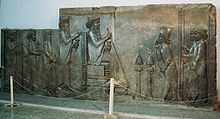Pharnakes I (Minister)
Pharnakes ( Elamite : Parnaka , old Persian : Farnaka ; † after 497 BC) was a nobleman and minister in the Persian empire of the Achaemenids in the 6th and 5th centuries BC. As the younger son of Arshama I , he was himself a member of the Achaemenid dynasty, his older brother was Hystaspes .
Under the rule of the great king Cambyses II , Pharnakes served in the 520s BC. As a follower of the governor Gobryas in Babylon . During these years his nephew Darius I usurped the throne of the great king against Gaumata after Cambyses II had died. Pharnakes served his nephew as chief administrator of the court in Persepolis , where his work has been handed down in several hundred preserved clay tablets. Together with his right hand, Ziššawiš, he organized and managed the food supply for the court and the allocations (rations) to family members or confidants of the king. Judging by the clay tablets that have been preserved, his term of office was between the sixteenth and twenty-fifth year of the reign (506–497 BC) of Darius, his successor in office was Aspathines.
Pharnakes is ascribed a pictorial representation in the famous Apadana reliefs of Persepolis (see picture), in a scene that was attached to the northern staircase of the palace complex. It shows him at an audience with the great king Dareios I, before whom he bows and brings his right hand to his mouth to kiss ( Proskynesis ), in his left hand he holds a staff. Behind Pharnakes are two guards of the palace guard ( apple bearers ), behind the enthroned great king is the crown prince, Xerxes .
Furthermore, two seals of Pharnakes (PF 2067 and 2068) have been preserved from the fund of clay tablets from Persepolis.
Pharnakes' son was Artabazos , who fought as a general against the Greeks and established a de facto hereditary governorship ( satrapy ) of his family, the Pharnakids , in the Phrygian Daskyleion .
The later royal dynasty of Cappadocia also derived its descent from Pharnakes in an obscure family tree, which was passed down by Diodorus (31.19). According to this, "King Pharnakes of Cappadocia" was married to Atossa, a sister of the great king Cyrus II , from whom the governors (including Datames ) and finally the kings of Cappadocia are said to have descended.
literature
- Heidemarie Koch : Dareios the King heralds ... About life in the great Persian empire (= cultural history of the ancient world . Volume 55 ). von Zabern, Mainz 1992, ISBN 3-8053-1347-0 .
Web links
- Jonah Lendering: Pharnaces (1) . In: Livius.org (English)
| personal data | |
|---|---|
| SURNAME | Pharnakes I. |
| ALTERNATIVE NAMES | Parnaka (Elamite); Farnaka (old Persian) |
| BRIEF DESCRIPTION | Economy Minister of the Great King Darius I. |
| DATE OF BIRTH | 6th century BC Chr. |
| DATE OF DEATH | after 497 BC Chr. |
